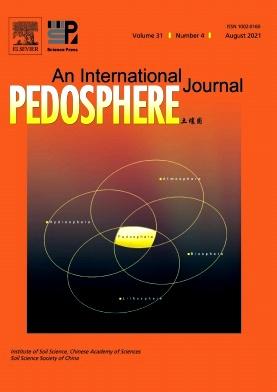Vermicompost maintains topsoil fertility by reducing NH3 volatilization and improving 15N/NO3- retention in a saline-alkali soil
IF 7.3
2区 农林科学
Q1 SOIL SCIENCE
引用次数: 0
Abstract
Nitrogen (N) loss is a major limiting factor affecting agricultural productivity in saline-alkali soils, with ammonia (NH3) volatilization and N leaching being the main sources of N loss. In this study, the dynamics of NH3 volatilization were measured using the open static chamber method (sponge sampling), alongside the distribution of 15N and NO3--N concentrations in layers, in a 30-cm soil column experiment with vermicompost addition after incorporation of 15N-labeled urea in the upper layer (0–10 cm) of a saline-alkali soil. Destructive sampling was conducted on days 20 and 60 of the column experiment to investigate the influencing factors of NH3 volatilization and 15N/NO3- retention, respectively. The results showed that the addition of vermicompost to saline-alkali soil decreased cumulative NH3 volatilization by 45.1%, decreased the 15N concentration in the bottom layer (20–30 cm) by 17.1%, and increased the 15N concentration in the upper soil by 48.7%. Vermicompost regulated the abundances of amoA, amoC, and nxrA genes, which can decrease NH3 volatilization by converting substrate NH4+ to NO3-. Additionally, Ca2+ adsorption is enhanced (increased by 6.2%) by increasing soil cation exchange capacity (increased by 20.6%), thus replacing the adsorption of Na+ (decreased by 13.8%) and decreasing the desorption of NH4+. Vermicompost enhanced the adsorption of NO3- by increasing Ca2+ and Mg2+ and decreasing Cl- by 30.4% in the upper soil. This study concluded that vermicompost addition can inhibit N loss by reducing NH3 volatilization and improving 15N/NO3- retention in saline-alkali soils.
蛭石堆肥通过减少盐碱土壤中 NH3 的挥发和提高 15N/NO3- 的保持率来保持表土的肥力
氮(N)损失是影响盐碱地农业生产力的主要限制因素,其中氨(NH3)挥发和氮淋溶是氮损失的主要来源。本研究在盐碱地表层(0-10 cm)添加15N标记尿素后添加蚯蚓堆肥的30 cm土柱实验中,采用开放式静态室法(海绵取样)测量了NH3挥发的动态,以及15N和NO3——N浓度在层内的分布。在柱式实验的第20天和第60天进行破坏性取样,分别考察NH3挥发和15N/NO3-保留的影响因素。结果表明:盐碱地添加蚯蚓堆肥使土壤NH3累积挥发减少45.1%,使表层(20 ~ 30 cm) 15N浓度减少17.1%,使表层15N浓度增加48.7%。蚯蚓堆肥调节amoA、amoC和nxrA基因的丰度,通过将底物NH4+转化为NO3-来减少NH3的挥发。此外,通过增加土壤阳离子交换容量(增加20.6%)增强Ca2+的吸附(增加6.2%),从而取代Na+的吸附(减少13.8%),减少NH4+的解吸。蚯蚓堆肥提高了土壤中Ca2+和Mg2+的吸附量,降低了30.4%的Cl-,增强了土壤对NO3-的吸附。综上所述,添加蚯蚓堆肥可通过减少NH3挥发和提高15N/NO3-滞留率来抑制盐碱地氮素流失。
本文章由计算机程序翻译,如有差异,请以英文原文为准。
求助全文
约1分钟内获得全文
求助全文
来源期刊

Pedosphere
环境科学-土壤科学
CiteScore
11.70
自引率
1.80%
发文量
147
审稿时长
5.0 months
期刊介绍:
PEDOSPHERE—a peer-reviewed international journal published bimonthly in English—welcomes submissions from scientists around the world under a broad scope of topics relevant to timely, high quality original research findings, especially up-to-date achievements and advances in the entire field of soil science studies dealing with environmental science, ecology, agriculture, bioscience, geoscience, forestry, etc. It publishes mainly original research articles as well as some reviews, mini reviews, short communications and special issues.
 求助内容:
求助内容: 应助结果提醒方式:
应助结果提醒方式:


